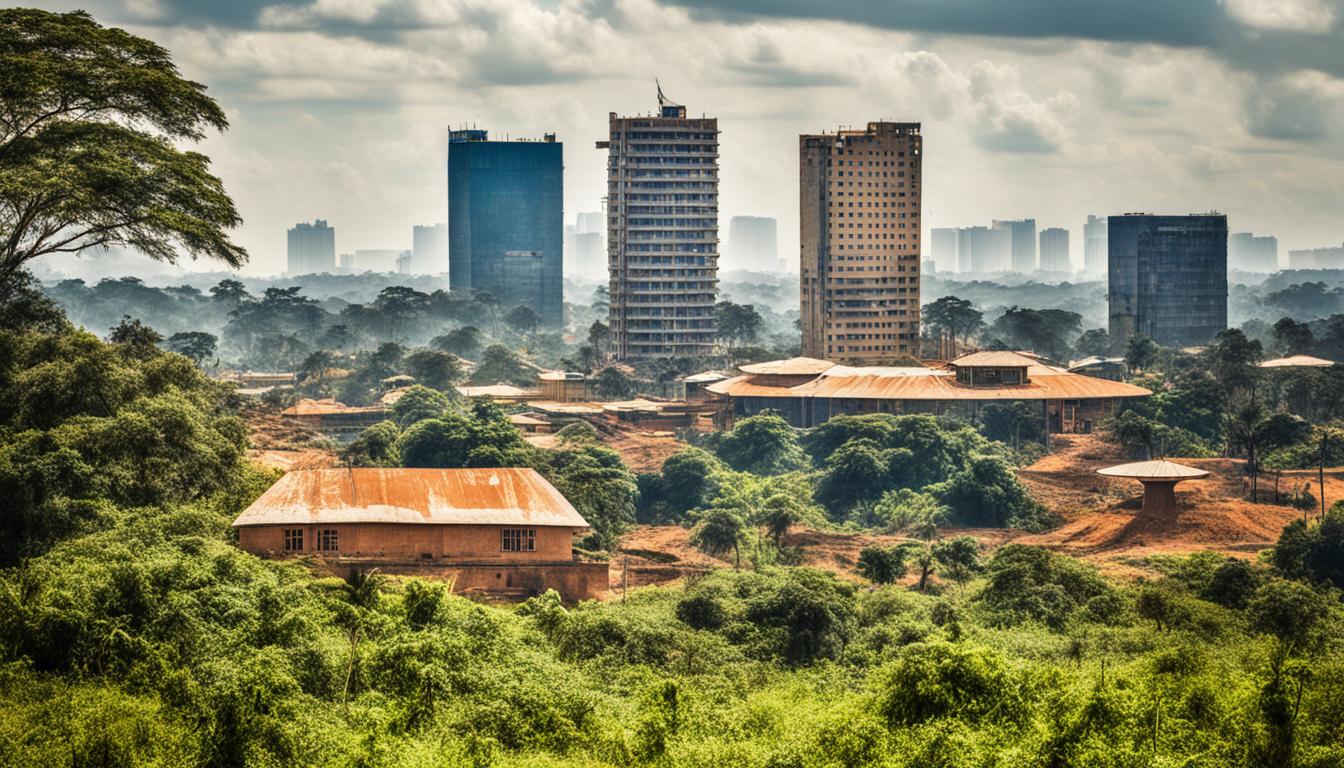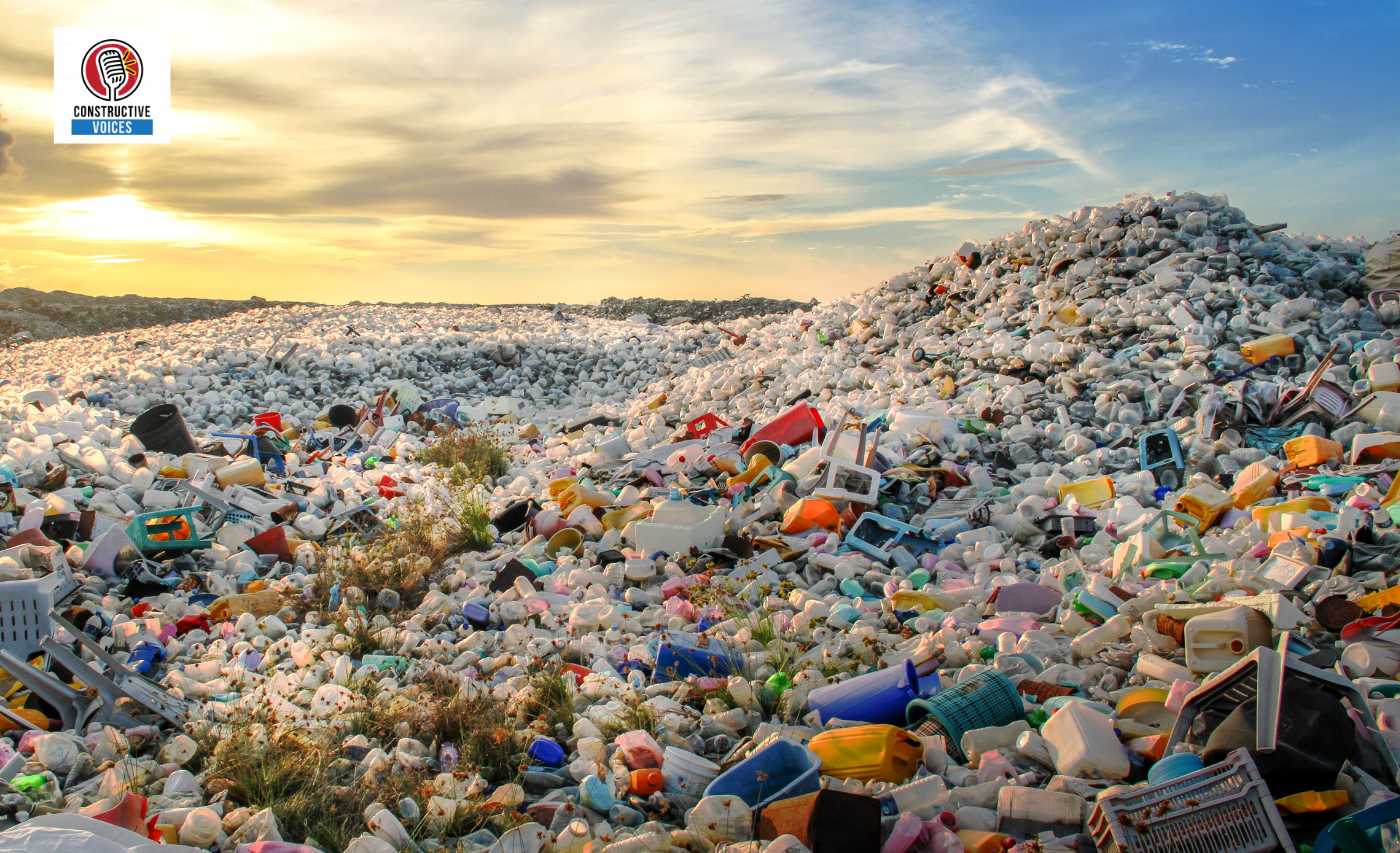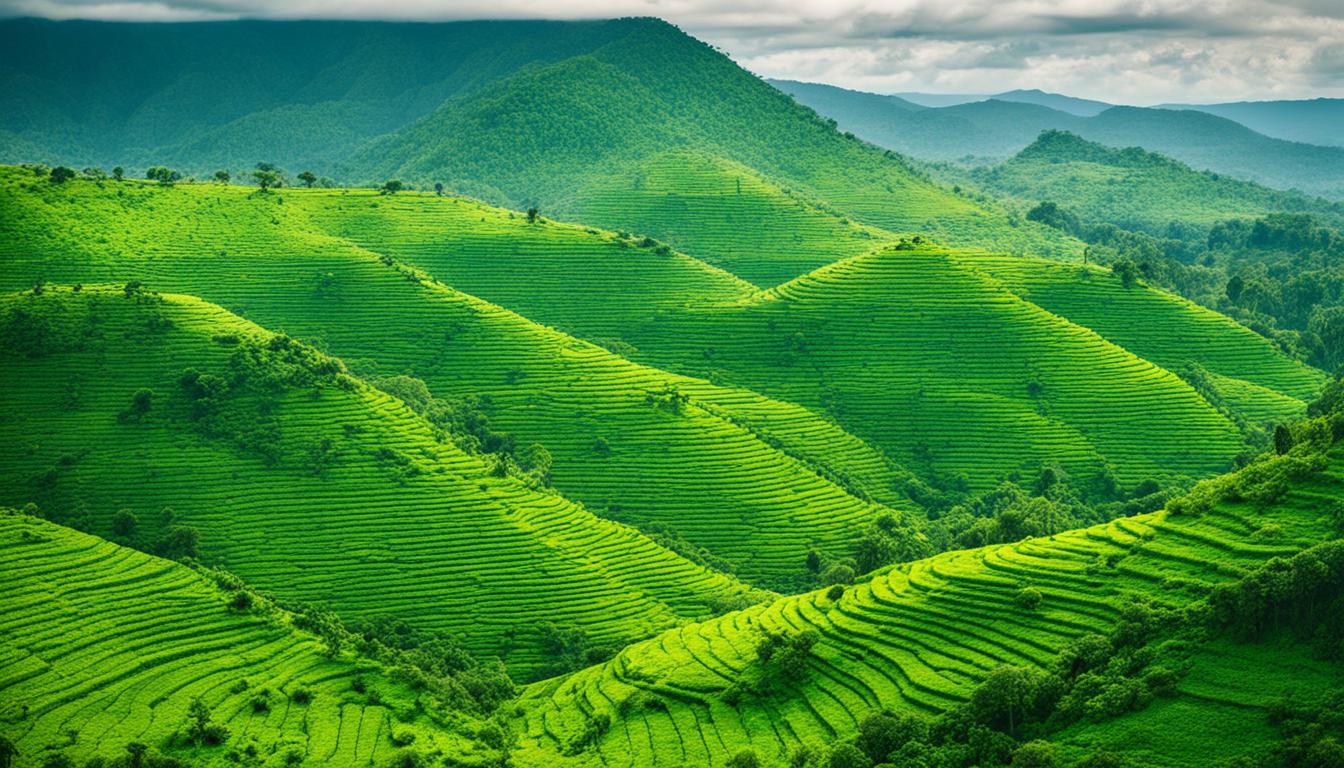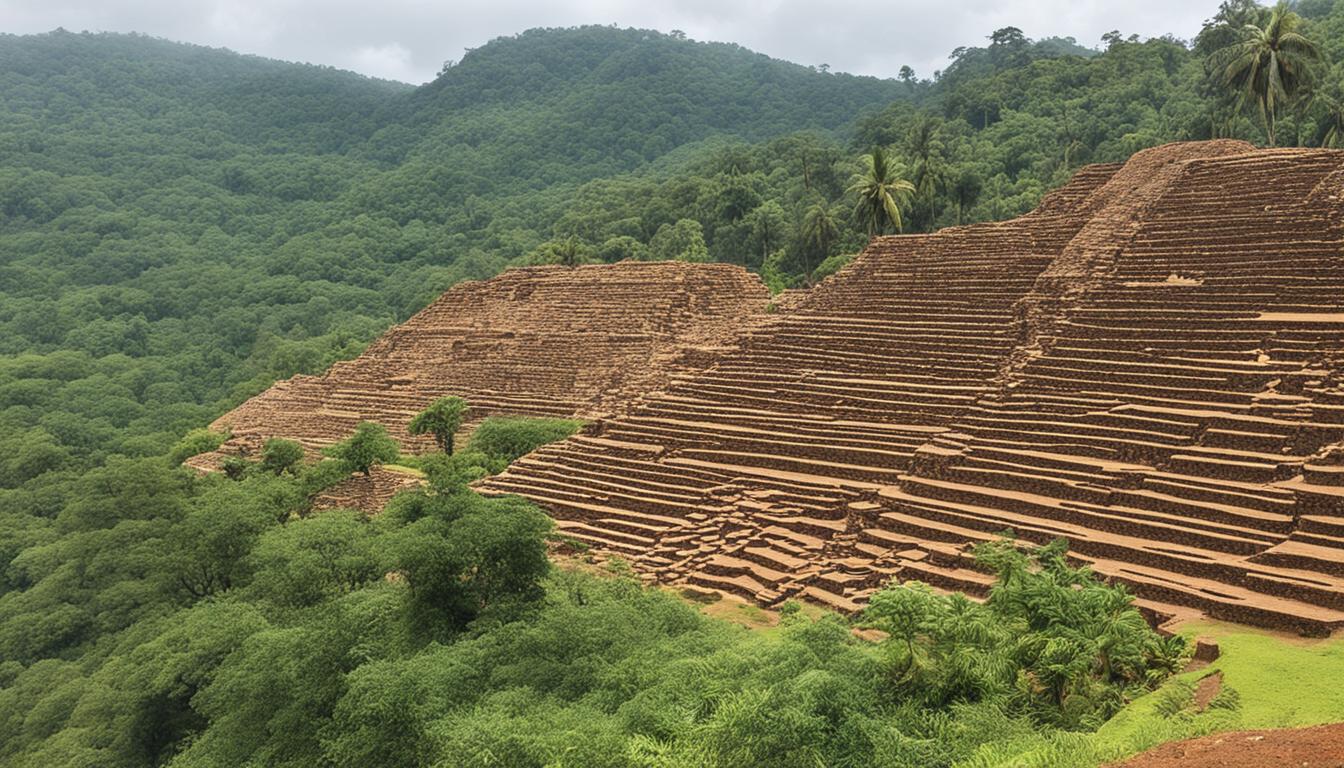Ukraine Biodiversity and the Built Environment
Ukraine, with its diverse ecosystems and rich biodiversity, is a treasure trove of natural beauty. Home to over 70 thousand species of plants and animals, this Eastern European nation is facing significant challenges in preserving its natural heritage. Anthropogenic activity and climate change pose threats to Ukraine’s biodiversity, while the ongoing war has had a devastating impact on the environment and wildlife.
However, despite these challenges, efforts are underway to conserve and protect Ukraine’s precious ecosystems. Nature conservation, urban planning, and environmental sustainability initiatives are being implemented to promote green infrastructure and ecological harmony. Biodiversity management strategies are being developed, and sustainable development practices are being embraced to ensure a better future for Ukraine’s natural resources.
Key Takeaways:
- Ukraine is home to over 70 thousand species of plants and animals.
- Anthropogenic activity and climate change threaten Ukraine’s biodiversity.
- The war in Ukraine has had a devastating impact on the environment and wildlife.
- Conservation efforts are underway, but there are implementation and monitoring challenges.
- Urgent action is needed to protect and restore Ukraine’s natural heritage.
Ukraine’s Rich Ecosystems
Ukraine is renowned for its diverse and thriving ecosystems, which encompass a wide range of habitats and support a remarkable variety of plant and animal species. One of the notable regions in Ukraine is the Carpathian region, home to extensive primary forests and old-growth forests. These ancient woodlands are of significant importance, providing crucial habitats for numerous species and contributing to the overall biodiversity of the country.
The primary forests in Ukraine, also known as virgin forests or ancient woodlands, are pristine ecosystems that have remained largely undisturbed by human activity. These forests have a unique natural balance and harbor rare and endemic species, making them invaluable for conservation efforts. Additionally, old-growth forests, characterized by their mature and untouched state, play a critical role in maintaining ecological stability and supporting the life cycles of various flora and fauna.
Ukraine’s commitment to biodiversity conservation is evident through its active participation in the Emerald network, a European-wide initiative aimed at identifying and protecting areas of ecological importance. With 377 objects recognized within the Emerald network, Ukraine has made significant strides in safeguarding its natural heritage and preserving its rich ecosystems.
However, challenges persist in Ukraine’s biodiversity conservation efforts. The country faces a high percentage of plowed land, resulting in fragmented habitats and reduced biodiversity. Additionally, the forest area in Ukraine falls below the European average, posing threats to the overall ecosystem health. In the steppe zone, only a small fraction of natural steppe ecosystems have been preserved, highlighting the need for concerted conservation measures.
“Ukraine’s natural wealth lies in its diverse ecosystems, including the ancient woodlands of the Carpathian region. Protecting and preserving these valuable habitats is essential for maintaining biodiversity and ensuring a sustainable future for Ukraine’s natural heritage.”
Biodiversity in Ukraine’s Ecosystems
| Ecosystem | Description |
|---|---|
| Primary Forests | Ancient woodlands largely undisturbed by human activity, hosting rare and endemic species. |
| Old-Growth Forests | Mature forests that have reached a state of natural equilibrium, supporting diverse flora and fauna. |
| Carpathian Region | A region in Ukraine known for its extensive primary forests and old-growth forests. |
Preserving Ukraine’s rich ecosystems, including its primary and old-growth forests in the Carpathian region, is crucial for biodiversity conservation. Urgent action is needed to address the challenges that threaten these invaluable habitats and to ensure the long-term sustainability of Ukraine’s natural heritage.
The Emerald Network
The Emerald network is an initiative of the Council of Europe aimed at protecting areas of particular ecological importance across European countries. It serves as a network of conservation sites, ensuring the preservation of natural habitats and promoting biodiversity conservation. By identifying and safeguarding these precious natural areas, the Emerald network contributes to the wider European effort to protect and preserve our shared natural heritage.
Ukraine’s commitment to the Emerald network is a testament to its dedication to ecological diversity and biodiversity conservation. The country recognizes the importance of preserving its natural habitats and the unique species that depend on them. Through its participation, Ukraine not only contributes to the conservation of biodiversity within its own borders but also plays a crucial role in the wider European conservation efforts.
“The conservation of natural habitats and the protection of biodiversity are critical for the sustainability of our planet. The Emerald network provides a platform for European countries to collaborate and address the pressing issues of habitat loss and species decline.”
Conservation efforts under the Emerald network focus on maintaining and restoring the integrity of natural habitats, ensuring the survival of endangered species, and promoting sustainable development practices that minimize the impact on biodiversity. By establishing a network of protected areas, the Emerald network acts as a catalyst for positive change in the conservation and management of Europe’s natural resources.
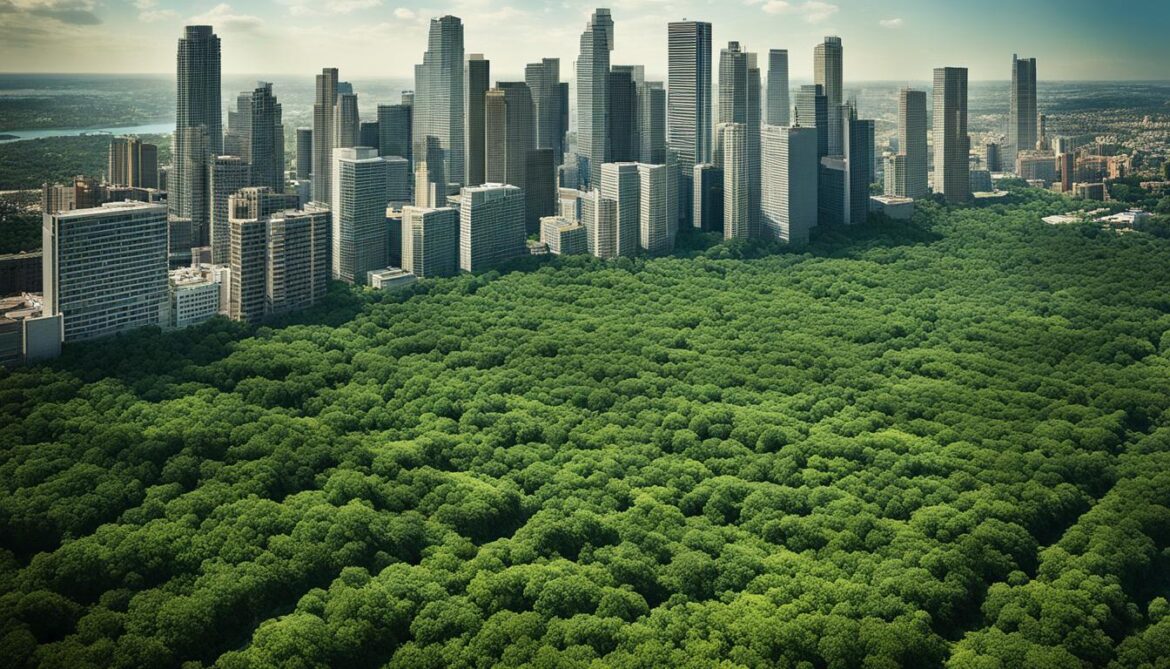
Threats to Ukraine’s Biodiversity
Ukraine’s remarkable biodiversity faces several significant threats that endanger its delicate ecological balance. The main threats to Ukraine’s biodiversity include habitat destruction, poaching, invasive species, and climate change.
Habitat destruction, especially due to agricultural activities, poses a major challenge to biodiversity conservation. As natural habitats are transformed or destroyed, many plant and animal species lose their homes and struggle to survive.
Poaching is another threat that disrupts the natural balance and puts endangered species at risk. Unregulated hunting and wildlife trafficking not only reduce the populations of vulnerable species but also disrupt the intricate web of biodiversity that relies on the interaction between different organisms.
Invasive species are non-native organisms that outcompete and displace indigenous species, threatening the survival of native flora and fauna. These invaders can disrupt ecosystems and alter the natural dynamics of habitats, further destabilizing Ukraine’s biodiversity.
Climate change exacerbates the challenges faced by Ukraine’s biodiversity. Rising temperatures, changing rainfall patterns, and extreme weather events pose significant risks to ecosystems and their dependent species. For example, climate change dries out pine plantations, making them more susceptible to pest infestations and increasing the risk of forest fires.
It is crucial to address these threats to Ukraine’s biodiversity through comprehensive conservation strategies, sustainable land management practices, and collaborations between stakeholders. Only by mitigating habitat destruction, combating poaching, managing invasive species, and implementing climate change adaptation measures can we protect and preserve Ukraine’s invaluable natural heritage for future generations.
Conservation Efforts in Ukraine
Biodiversity conservation in Ukraine is guided by a comprehensive national program for biodiversity preservation. The country recognizes the importance of protecting its unique ecosystems and is committed to the preservation of rare and endangered species. This is achieved through the establishment and management of various protected areas, including nature reserves, national parks, landscape reserves, and biosphere reserves.
Protected areas play a crucial role in safeguarding Ukraine’s rich biodiversity. These areas provide important habitats for a wide range of plant and animal species, allowing them to thrive and ensuring their long-term survival. By designating and managing protected areas, Ukraine aims to maintain ecological balance and prevent the loss of biodiversity.
In addition to its efforts at the national level, Ukraine actively participates in international initiatives to promote biodiversity conservation. One notable example is Ukraine’s involvement in the Emerald Network, an initiative of the Council of Europe. The Emerald Network aims to protect areas of special ecological importance across European countries, ensuring the conservation and sustainable management of habitats and species that are of significance at the European level.
Through its participation in the Emerald Network and other international partnerships, Ukraine strives to collaborate with neighboring countries and the wider European community to achieve shared goals in biodiversity conservation.
Protected Areas in Ukraine
Ukraine boasts a diverse range of protected areas, each with its unique characteristics and importance for biodiversity conservation. These areas provide a wide range of ecosystems and habitats, supporting a variety of plant and animal species.
The following table highlights some of the key protected areas in Ukraine:
| Protected Area | Type |
|---|---|
| Nature Reserves | Strictly protected areas primarily designated for scientific research and nature conservation purposes. |
| National Parks | Larger areas managed for the conservation of biodiversity, recreation, and environmental education. |
| Landscape Reserves | Areas with significant landscape and ecological value, intended for conservation, research, and sustainable land use. |
| Biosphere Reserves | Designated areas that aim to reconcile the conservation of biodiversity, sustainable development, and human livelihoods. |
These protected areas collectively contribute to the preservation of Ukraine’s biodiversity. By safeguarding these invaluable habitats, Ukraine is taking essential steps towards ensuring the long-term survival of its unique flora and fauna.
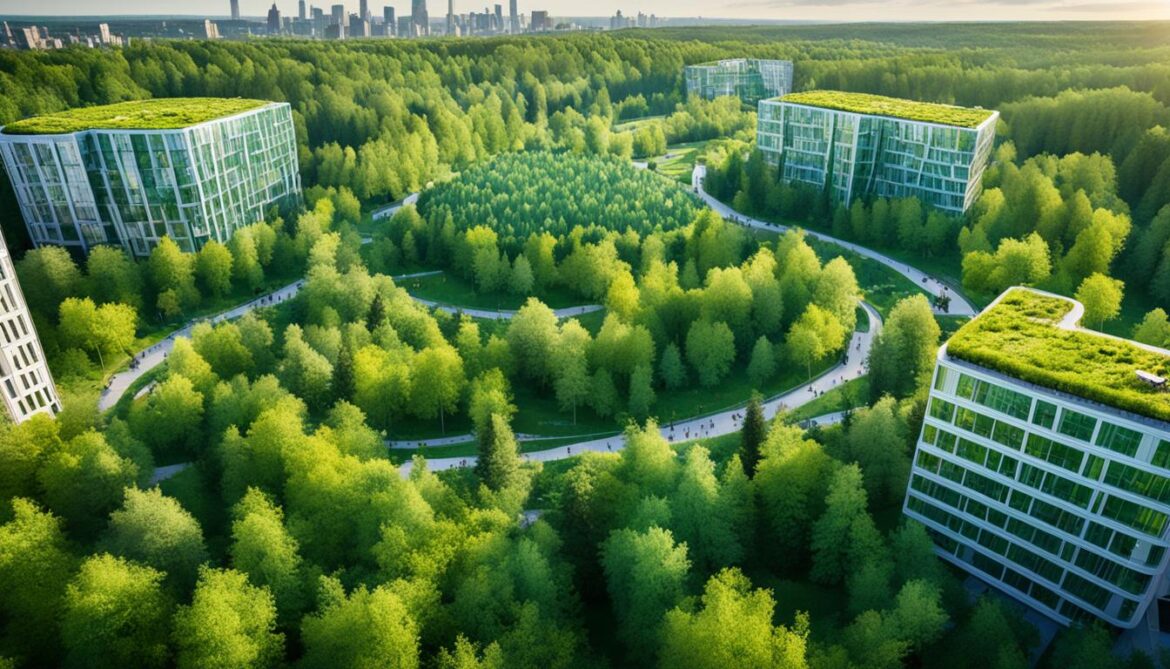
Impact of the War on Ukraine’s Biodiversity
The war in Ukraine has had a devastating impact on the environment and biodiversity. Approximately 20% of protected areas and numerous animal and plant species have been affected. Habitat destruction, deforestation, and forest fires have contributed to the loss of biodiversity. Marine life, such as dolphins, has also been disturbed, resulting in mass strandings on Black Sea beaches. Rehabilitation efforts will be required to restore damaged areas and protect the remaining biodiversity.
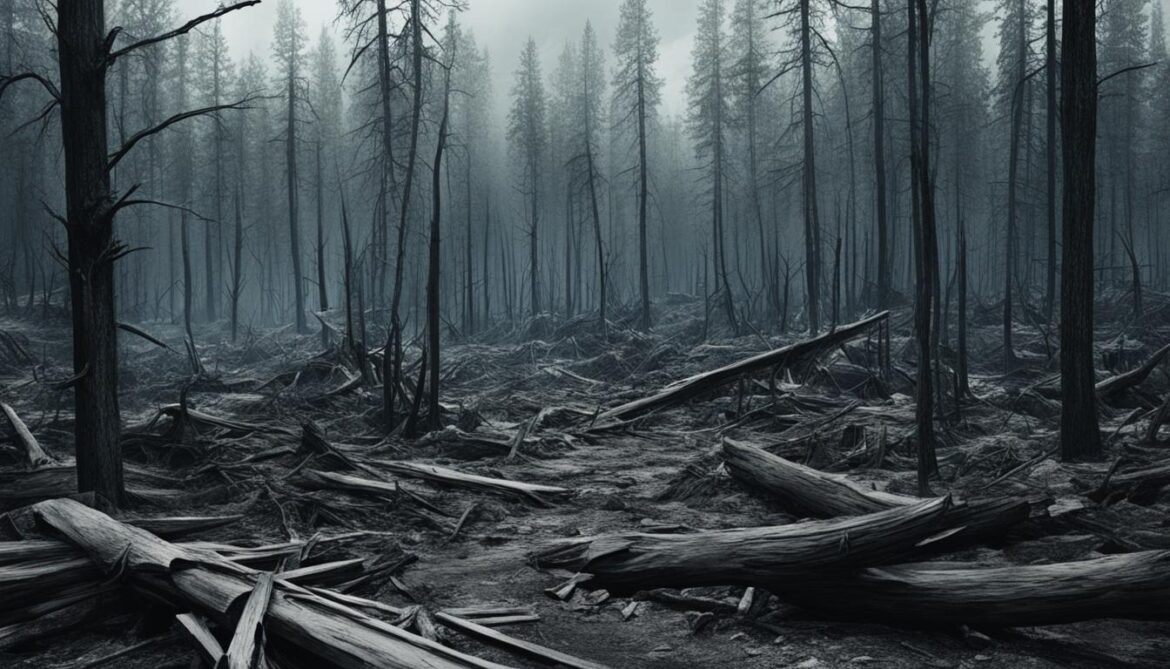
The war in Ukraine has resulted in significant habitat destruction and deforestation, leaving a lasting impact on the country’s biodiversity. Forests, wetlands, and other natural habitats have been damaged or destroyed, displacing numerous plant and animal species. The loss of these habitats disrupts the delicate balance of ecosystems and threatens the survival of many species.
Notably, forest fires have been a major consequence of the war, further exacerbating the environmental impact. These fires spread rapidly through the dry and damaged landscapes, destroying even more habitat and wildlife. The increased frequency and intensity of these forest fires pose a long-term threat to biodiversity in Ukraine.
“The destruction of habitats during the war has had a significant impact on Ukraine’s biodiversity. Wildlife populations have decreased, and the balance of ecosystems has been disrupted. It will take time and resources to rehabilitate these damaged areas and protect the remaining biodiversity.”
In addition to terrestrial habitats, the war has also affected marine life in Ukraine. Dolphin strandings along the Black Sea coast have increased, potentially due to disturbances caused by the conflict. These strandings represent a concerning decline in marine biodiversity and highlight the interconnectedness of different ecosystems.
Rehabilitation and Conservation Efforts
Efforts are underway to rehabilitate war-damaged areas and protect Ukraine’s remaining biodiversity. These initiatives involve restoring degraded habitats, implementing conservation measures, and enhancing monitoring and enforcement efforts. Collaboration between government agencies, non-profit organizations, and international partners is crucial in achieving these conservation goals.
Reforestation programs aim to restore lost forest cover and create new habitats for wildlife. Wetland restoration projects focus on rebuilding important ecosystems that provide essential functions such as water filtration and wildlife habitat. Conservation and management plans are being developed for protected areas to ensure their long-term preservation.
Moreover, public awareness campaigns promote the value of biodiversity and the importance of its conservation. Education and outreach programs engage communities in sustainable practices and encourage active participation in biodiversity protection efforts.
Impact of the War on Ukraine’s Biodiversity
| Impact | Description |
|---|---|
| Habitat Destruction | Loss of natural habitats due to war-related activities, leading to the displacement and decline of plant and animal species. |
| Deforestation | The destruction of forests, resulting in the loss of biodiversity and exacerbating the risk of forest fires. |
| Forest Fires | Increase in the frequency and intensity of forest fires, further damaging already vulnerable ecosystems. |
| Marine Life Disturbances | Dolphins and other marine species experiencing disruptions, such as mass strandings, due to the conflict’s impact on Black Sea ecosystems. |
The table above summarizes the key impacts of the war on Ukraine’s biodiversity. The cumulative effects of habitat destruction, deforestation, and forest fires pose significant challenges to conservation efforts and underline the need for urgent action to protect and restore the country’s natural heritage.
Dzharylhach National Park
Dzharylhach National Park is a protected area on Ukraine’s largest island. Situated in the Karkinitska and Dzharylgatska Bays Ramsar wetland, it holds the prestigious title of an Important Marine Mammal Area. The park is known for its diverse vegetation and serves as a haven for many rare and endangered species, including dolphins, porpoises, and sea turtles. This ecologically significant region is connected to the mainland by a long sand spit, creating a sheltered bay encompassing approximately 200 estuarine lakes (1).
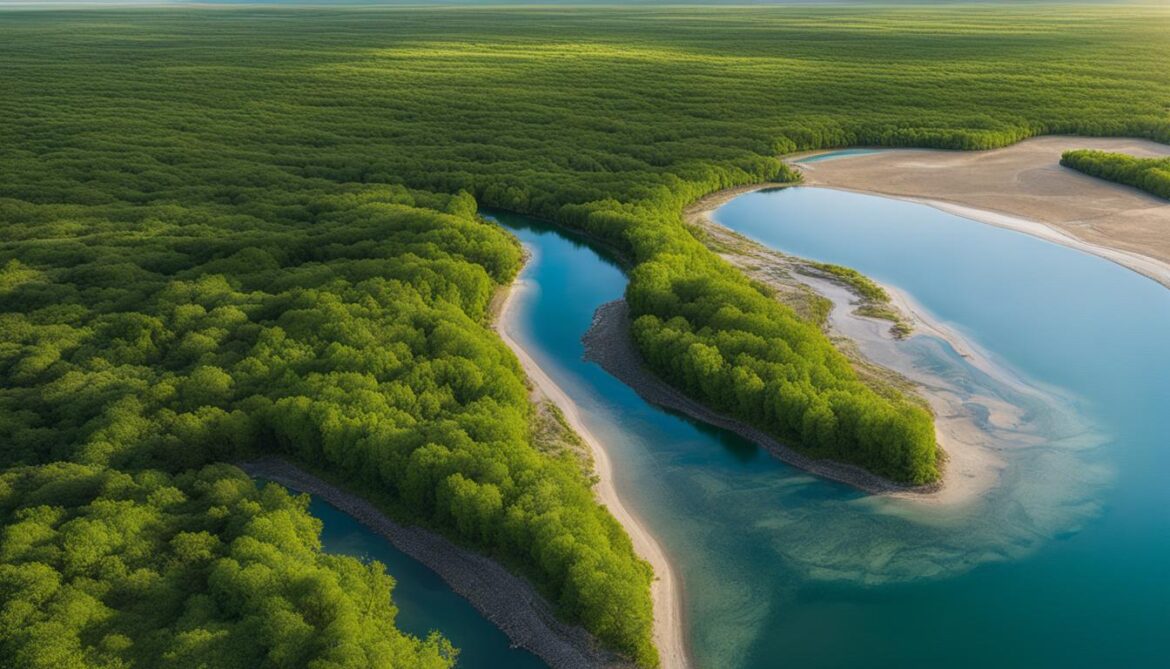
As a protected area, Dzharylhach National Park plays a crucial role in preserving the natural beauty and ecological balance of the region. It is an ideal habitat for a variety of species, making it an essential part of Ukraine’s efforts to protect biodiversity. The park’s location within the Ramsar wetland further underscores its significance on an international scale, highlighting its importance in the conservation of natural habitats and promoting sustainable development (2).
Dzharylhach National Park serves as an example of the delicate balance between nature and human intervention. It offers visitors the opportunity to explore and appreciate the richness of Ukraine’s natural heritage while raising awareness about the importance of preserving protected areas. By conserving this unique ecosystem and its associated flora and fauna, Dzharylhach National Park contributes to the overall preservation of Ukraine’s biodiversity (3).
The Importance of Estuarine Lakes
One of the notable features of Dzharylhach National Park is its extensive system of estuarine lakes. These bodies of water serve as essential habitats for a wide range of plant and animal species. Estuarine lakes support biodiversity by providing breeding grounds for fish, shelter for migratory birds, and feeding areas for numerous aquatic organisms. Additionally, they contribute to the overall health of the ecosystem by improving water quality, filtering pollutants, and reducing erosion (4).
Preserving an Ecological Jewel
Dzharylhach National Park’s recognition as an Important Marine Mammal Area affirms its status as a valuable ecological treasure. To ensure the continued preservation of this unique habitat, ongoing conservation efforts are needed. These efforts should focus on sustainable management, monitoring of wildlife populations, and raising awareness about the importance of biodiversity. By actively protecting Dzharylhach National Park, Ukraine is taking a vital step towards securing the future of its rich natural heritage (5).
| Key Features of Dzharylhach National Park | Importance |
|---|---|
| Protected area status | Preserving biodiversity and natural habitats |
| Estuarine lakes | Supporting diverse aquatic ecosystems |
| Ramsar wetland designation | International recognition of ecological importance |
| Home to rare and endangered species | Conservation of threatened wildlife |
Visiting Dzharylhach National Park provides an opportunity to witness the beauty and diversity of Ukraine’s natural landscapes, while also contributing to the conservation efforts that protect this unique ecosystem for future generations to enjoy. By preserving and appreciating Dzharylhach National Park, we can support the continued existence of its remarkable plant and animal life, ensuring the long-term ecological sustainability of Ukraine’s protected areas (6).
References
- Park Guide, Dzharylhach National Park
- Ukraine State Agency of Forest Resources (2020). “Ukraine’s Protected Areas: A Foundation for Ecosystem Services and Environmental Stewardship.”
- Ukraine Ministry of Ecology and Natural Resources (2018). “Strategy for the Development of the Protected Area Network in Ukraine for the Period up to 2030.”
- European Environment Agency (2016). “Estuarine and Coastal Ecosystems and Threats.”
- Ramsar Convention on Wetlands (2021). “Dzharylhach and Staryi Sambir Ramsar Sites Join UNEP/AEWA Important Marine Mammal Areas.”
- World Wildlife Fund Ukraine (2021). “Exploration of Ukraine’s Protected Areas: Dzharylhach National Nature Park.”
Impact of the War on Dzharylhach National Park
The war has had a significant impact on Dzharylhach National Park. Instead of being used for hunting, fishing, and tourism as originally planned, the park has been converted into a military training ground. The presence of military forces has resulted in habitat damage, pollution from military activities, and the destruction of vegetation due to fires. The recent storm damage has also caused breaches in the spit, posing further risks to the bay’s habitat and ecosystem.
Due to the war, Dzharylhach National Park, which was once a haven for nature enthusiasts and a thriving ecosystem, has now become a victim of the conflict. The conversion of the park into a military training ground has led to the destruction of habitats and the disruption of wildlife. The sounds of gunfire and military activities have driven away many species, impacting the delicate balance of the ecosystem.
Military training exercises have caused extensive habitat damage within the park. Heavy machinery and vehicles have trampled over sensitive areas, destroying vegetation and disrupting the natural habitats of various species. This destruction has severe consequences for the biodiversity of the park, with many species losing their homes and struggling to survive in the altered landscape.
“The war has not only impacted the lives of people but has also inflicted irreparable damage on our natural heritage. The conversion of Dzharylhach National Park into a military training ground has caused immense harm to the fragile ecosystems and wildlife that once thrived here.”
Pollution resulting from military activities has further exacerbated the environmental impact on Dzharylhach National Park. The disposal of hazardous materials, improper waste management, and the release of pollutants into the air, land, and water have contaminated the park’s ecosystems. The pollution has not only disrupted the natural balance but also poses risks to the health of the remaining flora and fauna.
The destruction of vegetation due to fires caused by military training exercises has also been a significant concern. The fires have ravaged the park, burning down trees, shrubs, and grasslands that once provided essential habitats for a variety of species. The loss of vegetation has further heightened the vulnerability of the park’s ecosystem, leaving it more susceptible to erosion, invasive species, and habitat loss.
In addition to habitat damage and pollution, recent storm damage has caused breaches in the spit that connects the island to the mainland. These breaches pose further risks to the bay’s habitat and ecosystem, allowing saltwater intrusion and disrupting the delicate balance of the estuarine ecosystem. Furthermore, the storm damage has increased the vulnerability of the park to future natural disasters, making it even more challenging to restore and protect the remaining biodiversity.
Efforts to mitigate the impacts of the war on Dzharylhach National Park are crucial to preserving its remaining biodiversity. Rehabilitation projects, habitat restoration, and pollution control measures are necessary to repair the damage caused by the military training activities. Additionally, implementing strict environmental regulations and monitoring systems can help prevent further harm and protect the park’s fragile ecosystems.
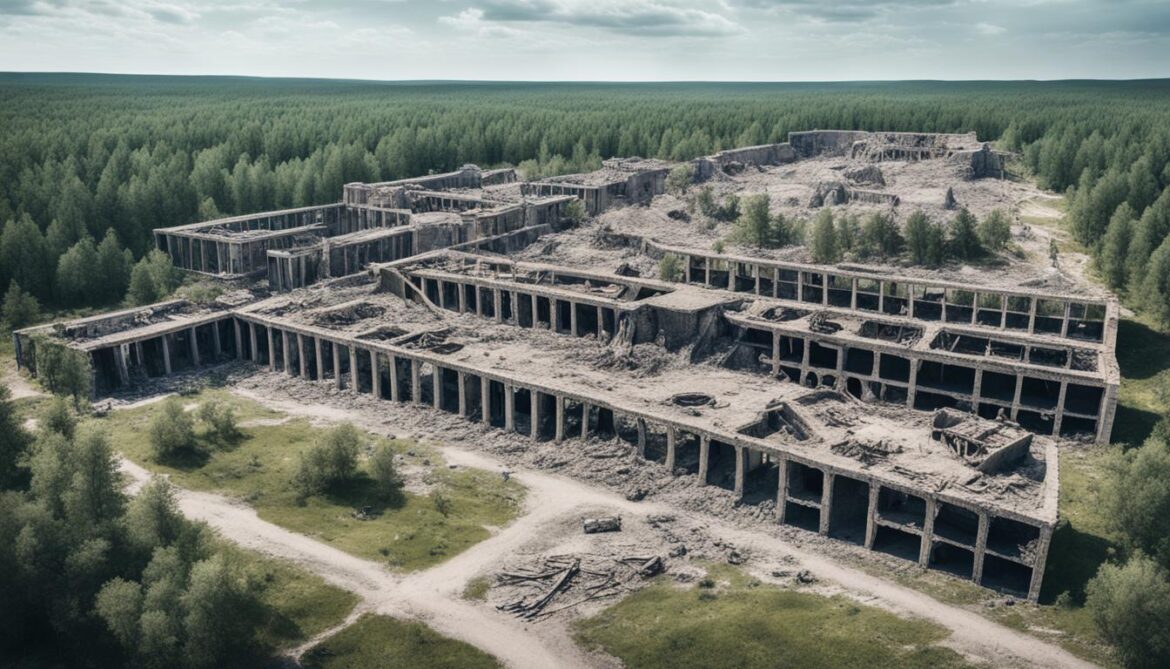
Biodiversity Assessment for Ukraine
A biodiversity assessment conducted for Ukraine provides valuable insights into the status of biodiversity, threats to biodiversity conservation, and the existing policy framework. This assessment plays a crucial role in understanding the current state of Ukraine’s diverse ecosystems and guiding conservation efforts.
Assessing the Status of Biodiversity
The biodiversity assessment reveals the rich and diverse natural heritage of Ukraine. It highlights the presence of numerous unique species of plants and animals, as well as the importance of preserving their habitats. By assessing the status of biodiversity, scientists and policymakers can better understand the challenges and opportunities for conservation.
Through this assessment, it has been determined that Ukraine is home to a significant number of endangered and threatened species. These findings underscore the urgent need for protective measures to ensure the survival of these vulnerable organisms and the ecosystems they inhabit.
Identifying Threats to Biodiversity Conservation
The biodiversity assessment also sheds light on the threats facing Ukraine’s biodiversity. It identifies factors such as habitat destruction, pollution, climate change, and human activities as major challenges to conservation efforts.
“The assessment highlights the pressing need for increased protection of threatened ecosystems and improved land use practices, which are essential for safeguarding biodiversity. It is crucial to address these threats and implement effective strategies to mitigate their impacts.”
By identifying these threats, policymakers and conservationists can develop targeted interventions and conservation plans to address the specific challenges faced by different ecosystems and species.
Evaluating the Existing Policy Framework
The biodiversity assessment also evaluates the policy framework in place for biodiversity conservation in Ukraine. It examines the effectiveness of existing laws, regulations, and initiatives in protecting and managing biodiversity.
The findings of the assessment reveal the need for enhanced transparency, stakeholder engagement, and adaptive management approaches within the policy framework. These recommendations aim to ensure that decision-making processes consider the long-term sustainability and conservation of biodiversity.
Monitoring and Addressing Impacts
One of the crucial aspects highlighted by the assessment is the importance of monitoring and addressing the impacts of ongoing programs and projects on biodiversity. This includes identifying potential negative impacts and implementing measures to mitigate them.
Effective monitoring and evaluation systems can provide valuable data to assess the success of conservation initiatives, identify areas of concern, and inform adaptive management strategies. With this information, policymakers and stakeholders can make informed decisions to protect and restore biodiversity in Ukraine.
Building a Sustainable Future
The biodiversity assessment serves as a valuable tool for guiding conservation efforts in Ukraine. By understanding the status of biodiversity, identifying threats, evaluating the policy framework, and emphasizing the need for monitoring and addressing impacts, stakeholders can work together to build a sustainable future for Ukraine’s unique and valuable ecosystems.

Conclusion
The rich biodiversity of Ukraine faces numerous challenges, including habitat destruction, poaching, invasive species, and climate change. Efforts to conserve and protect Ukraine’s biodiversity are underway, but further action is needed. Recommendations include increasing protection of threatened ecosystems, improving land management practices, strengthening conservation policies, and supporting biodiversity-friendly initiatives. It is vital to address these challenges and work towards sustainable biodiversity conservation in Ukraine.




